GB Railfreight Fleet Engineer (Traction) Bob Tiller calls the Class 73 “a successful British Rail project”. His boss, Managing Director John Smith, calls them “very useful little engines”.
There is a lot of appreciation for the locomotives. Their versatility demands that. But the problem with them is two-fold: they are old (the first examples date from 1962), and their diesel engines are known to overheat, causing reliability woes.
While there have been instances of the ‘73s’ working away from third-rail metals, it is usually as a pair, and never on particularly taxing duties. But an innovative project designed by GBRf will change that. A Class 73 on the West Highland Line suddenly doesn’t seem such a bizarre thought.
Class 73s are an electro-diesel design. They were ordered by the Southern Region, which needed a versatile locomotive capable of running on its third-rail system, but which could also use a diesel engine on non-electrified routes and within yards and depots.
Forty-nine locomotives were built. First was E6001, which debuted in February 1962, and which was one of six prototype ‘JA’ locomotives built that year at Eastleigh Works. The locomotives drew power through eight collector shoes fitted to the bogies. When operating on diesel power, they used an English Electric 600hp 4SRKT engine.
Forty-three production locomotives (E6007-E6009) were then built by EE at Vulcan Foundry in Newton-le-Willows in 1965-1967, and classified ‘JBs’.
The differences between the ‘JAs’ and the ‘JBs’ were small, but the latter were fitted with more modern bogies and a different traction motor. This allowed them to have a 90mph maximum speed, rather than the 80mph top speed of the first six.
All 49 were dual-braked and fitted with electric train heat that was used only on electrified lines. The ‘73s’ were built to the narrower ‘Hastings’ gauge, which offered greater flexibility to the Southern Region. The six ‘JAs’ were numbered 73001-73006, while the ‘JBs’ became 73101-73143.
They were later used by Gatwick Express for passenger trains, with 14 allocated to this duty and renumbered 73201-73213/235. The rest passed to EWS in privatisation, and carried on working on the SR until the late 1990s, when most were withdrawn. Many were preserved or sold to other users.
Initially, GBRf is rebuilding five locomotives. Three (73209/204/206) are at Wabtec Rail’s Loughborough facility, from where they will emerge this year as 73961-73963. They will be followed by 73964/965, which are expected to be converted from 73208/205.
Currently the contract is for five locomotives, but Tiller expects more to be converted.
“There is significant work for the next ten years. These locomotives have not visited works since 1991/1992, and were due a visit. They need an overhaul. They need a new engine. We are investing over a long period here. By replacing the English Electric with the MTU engine, we are creating a Type 3 locomotive that is versatile and can go anywhere.”
He explains the immediate need: “Five will be for Network Rail. There is a ten-year deal for specific projects. A significant number may well be repowered, but that is not confirmed.
“The old design overheated. Working on heavy NDS work for Network Rail would see them overheat.” Tiller says modifications were carried out to prevent this, but this was not a long-term solution.
Brush Traction Head of Projects UK Chris Moss says: “We are reinvesting in re-engineering. The work is invaluable for experience.”
Why do the work? Tiller explains: “The key for the next ten to 20 years is spares. Even windscreen wiper motors are hard to source.”
He says that by significantly rebuilding the locomotives, this becomes “a vastly different locomotive”. And by fitting many new components, it provides a new locomotive that will have spares availability for many years to come.
The key, however, is that this is not a new locomotive… it is a repowering project.
Rather than a class rebuild, like the Class 57 conversion project with which Brush was involved between 1998 and 2004, this is more akin to the MTU engine project on High Speed Train fleets (that Brush was also involved in) between 2006 and 2011.
Tiller was hugely involved in the latter. A senior member of the Diesel and Electric Preservation Group, he knows hydraulic equipment. And through his DEPG contacts and the need for Maybach components, it is his relationship with MTU that provides the equipment.
When the First Great Western HST power cars were fitted with MTU engines, Tiller led the project. Even now, Tiller says that no other companies would have been considered - MTU and Wabtec were the only options, he says.
The locomotives retain their multiple working equipment, but their operation needs to change, and so new equipment needs to be fitted. They have to not only work with other ’73/9s’, but also other ‘73s’, Class 66s, Network Rail Driving Van Trailers, and NR Guards Luggage Vans. The electric train heat equipment has been retained, but for the first time it will be able to work on diesel power as well as electric.
The English Electric (EE) engines were supposed to provide 600hp. But Moss explains that when they were load banked at Loughborough, they offered only 420hp (70hp more than an ‘08’). In contrast, Tiller says a test run in Kent showed the electric power of a ‘73’ could reach 2,400hp (nearly that of a Class 47).
The plan is for the new MTU engine to offer 1,600hp, a significant improvement in power. “It is a dual-mode Type 3,” says Tiller.
He explains that the new MTU engine, although wider, is more than three tonnes lighter than the less powerful EE engine. It is also more economical in terms of fuel. Because of the lighter weight of the engine, ballast blocks have been installed inside the locomotive.
The rebuilt ‘73s’ are being fitted with brand new engines and alternators. The traction motor blowers are being retained, while air intake filters are being fitted at the cantrail.
A lot of the design is based on the HSTs fitted with MTU engines. “It is half an HST,” says Tiller. He adds that the MTU engine requires a lot of air to keep it cool, hence the additional grilles on the cantrail.
Pre-heaters are being fitted to the locomotives. The temperature must be 25°C for an MTU engine to fire up, and the pre-heater warms the engine, enabling it to be started. This will apply for when working on either electric or diesel duties.
A new exhaust silencer has been fitted to the locomotive - it is in a well, so effectively it is out of the engine. A new hydraulic cooler group has also been installed. “I had to get something hydraulic in it,” smiles Tiller.
There are still two cubicles for electrics, although all the auxiliary systems are now AC motor-driven. This cuts down on maintenance requirements, says Tiller. There is a chopper cubicle for the controls for the motor, and Tiller explains that this should give an improved motor performance.
The brake system on the ‘73/9s’ has been simplified - the design was built to operate with many different trains, and so all manner of components formed the brake system. Some are still fitted with vacuum brakes, but that will change. Two locomotives (73119 and 73136) remain dual-braked, and these will be the last to be rebuilt, because they currently offer even more flexibility.
A Capos power supply is being fitted to the rebuilt locomotives. This is fitted to MTU engines across the globe, and enables engines to be started, and then hold the charge.
Says Tiller: “The locomotive doesn’t therefore need to rely on traction batteries to start. This is the first time this has been used in the UK, and is a big reliability key for the locomotive.”
Inside the cabs, the twin driving position has been retained, and new indicators and lamps are being fitted.
The distinctive indicator blinds, so common of SR designs, have been removed and the central window blanked out. Partly this has been done for cost reasons, as a windscreen costs more than £10,000 to fit to today’s safety standards. That would be more than £20,000 per locomotive, more than £100,000 for the current five ‘73s’ in the project, and potentially more than £300,000 on unnecessary glass for which GBRf would have to pay.
So Tiller isn’t paying. Instead, invertors and GSM-R (Global System for Mobile Communications - Railway) radio equipment will be fitted behind the blanked out panel.
Additional soundproofing has also been fitted to the cabs, while the windows have been sealed shut. This will surely prove popular when travelling along the West Highland Line on a freezing winter’s night.
New headlights have been fitted to the locomotives, as well as a roof-mounted headlight. The locomotives retain their roof-mounted horns. And on the cab front, while the multiple working pipes remain, a multiple working plug (a 27-way AAR system) and socket (as fitted to the Class 66s) is also now a feature.
Tiller says 73212 and 73213 are the only GBRf ‘73s’ fitted with snowplough brackets, and while these prove useful, there are no plans for more to be fitted. “We only have three sets of ‘ploughs anyway,” he says.
Life expectancy of the newly rebuilt locomotives should be 25 years. GBRf owns them outright, and has no plans to sell them. Talk of selling them to a company such as Network Rail, and then hiring them back (in that way paying for the cost of the rebuild), has been denied.
And more locomotives will be acquired if needed - indeed, in the past two months, 73107/109, 73201 have been added to the fleet.
So what will the rebuilt locomotives do?
“They will move across the UK,” Tiller tells RAIL. “They will probably be used on the New Measurement Train, and they will run in Scotland.” Also, while on the move, they will be able to switch from diesel to electric and vice-versa.
St Leonards depot will remain home to the GBRf ‘73’ fleet. “There will be a couple of depots where they will be based,” adds Tiller, although where has not been specified. GBRf has a depot at Peterborough, and uses Doncaster Roberts Road.
Livery-wise they will emerge in GBRf colours, meaning that 73119, 73201/205/207/
208 will lose their heritage liveries. The locomotives will keep their names, although 73963 will lose its name as the staff member after whom it was named has left the company.
When production is up and running, each locomotive should take 18 weeks to complete. The first two locomotives have taken significantly longer, with 73209 arriving at Loughborough in autumn 2012 and 73204 in April 2013. The third machine (73206) arrived in November.
Tiller adds: “We believe this will be a more reliable and versatile locomotive, and have better fuel economy than other designs.”
They are not to be fitted with tripcocks, which rules them out (initially) of working on the London Underground network.
“But that is not to say we cannot do that, and that we do not have a plan,” says Tiller. “Anything going onto the LU network, which has a fourth rail, would need bogie modifications.”
Testing should begin in March. Initially this will be for a four-week period at Loughborough, after which 73951 moves to the nearby Great Central Railway for a further four-week period, for running tests away from the national network. Testing-wise, 73962 is four weeks behind it, but will not visit the GCR.
The locomotives being rebuilt were initially chosen because of their condition. The first (73209) had technically been withdrawn. It had been used as a shunter at Celsa’s steelworks in Cardiff, but suffered fire damage. It was deemed surplus to requirements, and faced a gloomy future until this opportunity presented itself. Today, it is sparkling and looks brand new, although it will sound a bit different.
Second to be chosen was 73204 (which needed an overhaul), and then 73206 (which had life-expired wheelsets). Next to be rebuilt should be 73208 and 73205, as they have been out of works the longest.
73205 was used for high speed tests on the national network in the late 1980s/early 1990s, in connection with the Eurostar developments. It ran around with a converted SR unit and 83301 (originally 33115, but which had been converted into a driving van trailer for the project).
Says Tiller: “73207 is in that position, too , but it has a decent life in it yet.” It spent many years during its early GBRf career as a depot shunter at Whitemoor Yard.
Drivers will need to learn the controls of the newly rebuilt ‘73s’, but Tiller envisages this will only be a two-day or three-day course.
Walking around the locomotives on January 17, it is clear just how much work is needed.
Stripped down, 73963 (which is to be rebuilt from 73206) looks a wreck. There are large lumps of rust, and a hole in the cab floor. Its innards have gone, and it is literally a shell. But in a few weeks, this will be a working locomotive.
Across the workshop floor, 73961 is taking shape. Painted in grey undercoat, it is minus a roof and floor, but it looks fantastic. Wabtec engineers busy themselves on the ‘73’.
Tiller says that this is the first time the locomotives have been stripped back to full metal since they were built. And when taking the ‘73s’ apart, they found a few surprises, such as animal skeletons - mainly mice that had been killed when looking for somewhere warm.
The ‘73’ is an incredibly versatile locomotive in its current BR design. But this new innovation - a collaboration between GBRf, MTU and Wabtec Rail - promises so much more. It offers GBRf more flexibility, and the opportunity to release Class 66s to duties elsewhere.
Suddenly, the thought of a pair of ‘EDs’ hauling heavy freight away from the third rail system doesn’t seem so outlandish.

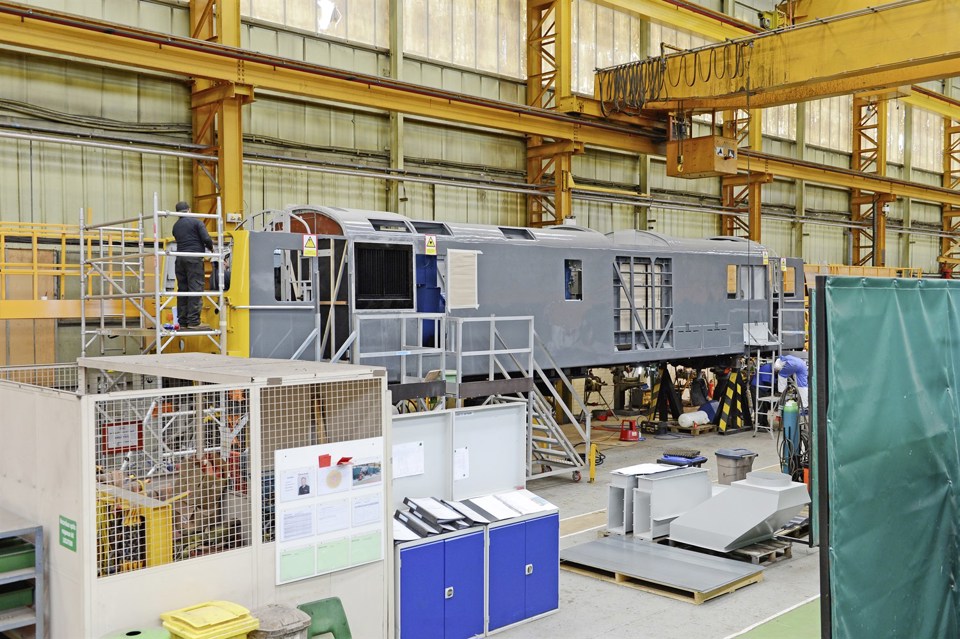
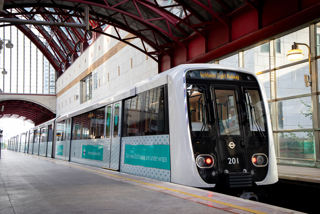
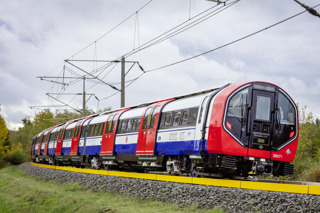
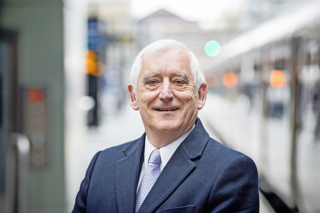
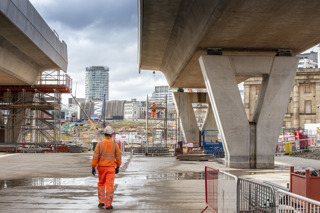
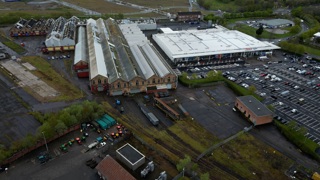











alan rogerson - 07/04/2015 20:57
A truly versatile loco would have a diesel engine and a 25kv ole capability. Is this not possible with this loco? Was it ever considered? The only big contract so far is the Sleeper, hundreds of miles from the nearest third rail.